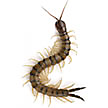CENTIPEDES
Have you spotted a centipede speeding along your kitchen floor or crawling inside the tub? TERRO® has multiple solutions to help you get rid of the centipedes inside your home.
What are Centipedes?

A scientist will tell you that centipedes aren’t insects; instead, they will explain that centipedes are actually myriapods, making them distant cousins to insects. Their most notable feature is their elongated body and dozens of legs, an obvious feature that separates them from insects. As insectivores, centipedes hunt other bugs and paralyze them with a venomous sting.
The word centipede means “hundred feet,” but there are no centipede species that have exactly 100 legs. Depending on the species, they may have as few as 30 and as many as 354 when mature.
About 3,100 centipede species have been identified by scientists, and these bugs are found across the globe – some species even live above the Arctic Circle.
What Attracts Centipedes?
Centipedes are drawn to an environment that offers them three key things:
- Food: Most of all, centipedes are driven by the need for food. As hunters, they’ll seek out prey wherever it’s abundant, and that may be inside your home.
- Shelter: When not hunting for food, centipedes seek out places to rest. Outside, they will crawl under rocks, inside rotting logs or under leaf litter. Inside a home, they’ll seek out crevices in walls, wiggle under cardboard boxes and even hide inside a floor drain.
- Moisture: Centipedes need a high-humidity environment to survive. Too dry and they dehydrate, which will kill them. As a result, basements and crawlspaces, which trap moisture, can be ideal habitats for some centipedes.
What Do Centipedes Eat?
Centipedes are insectivores, meaning they eat small insects, spiders, mites and other arthropods. They are generally nocturnal hunters.
For centipedes, speed is their best hunting tool. Upon sensing prey, they will move quickly to attack. Once they’ve captured their meal, most will use a poison to incapacitate their prey before consuming it.
Are Centipedes Dangerous to People or Pets?

In general, people and pets have nothing to fear from the centipedes they encounter. In fact, many dogs and cats will eat the centipedes they catch.
Still, it’s important to remember that most centipedes use a poison on their prey. Centipedes deliver this poison through a pair of forcipules that are situated near their heads. These hollowed-out, pincer-like limbs can be used in times of desperation, too, and they may be used to deliver a sting if they are picked up or stepped on. Most centipedes, however, don’t have the strength to pierce human skin.
One exception to that is the Florida blue centipede. This outdoor centipede is said to react aggressively against anyone who bothers it. People who have encountered this centipede, which can grow to about 3 inches long, say it delivers a sting that rivals a bee sting. It’s mainly found in the southeastern U.S.
What Do Centipedes Look Like? How Do You Tell a Centipede from a Millipede?
Centipedes are elongated arthropods with multiple body segments and usually move extremely fast. While centipedes share the Myriapoda branch of the “tree of life” with millipedes, they are anatomically different. Most notably, centipedes have one pair of legs per body segment and millipedes have two. Further, millipedes have round, blunted heads that turn downward, while centipedes are built like predators with visible eyes and forward-facing mouthparts.
Another key difference is that centipedes have forcipules, a set of poison-injecting pincers. Since millipedes don’t eat living creatures, they don’t need these pincers.
The Centipede Life Cycle
After courtship, the female centipede lays between 10 and 60 eggs. The eggs develop for a few months before hatching. Young centipedes have fewer leg pairs than adults, and, with each molting, they add body segments and more leg pairs until fully grown.
Unlike most other arthropods, centipedes can be quite long-lived. Some species are known to reach the age of 7. Most other arthropods generally have a lifespan of a year or less.

